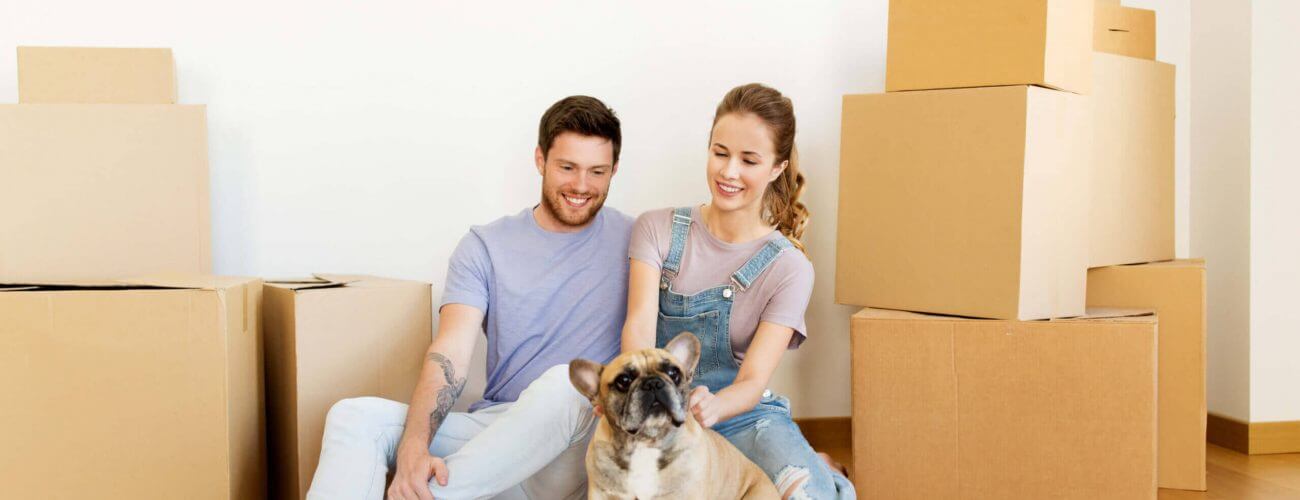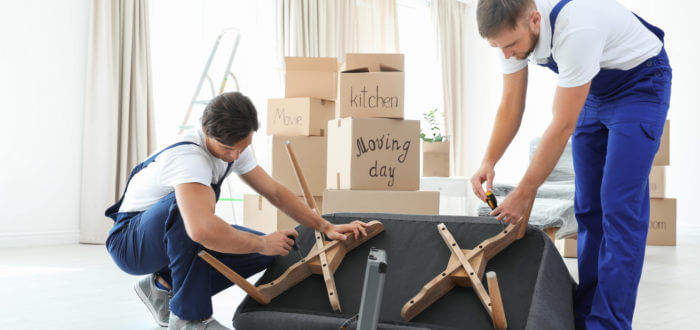

Easy Tips on How to Move Efficiently
Posted in How-to,Moving Essentials,Moving Tips & Tricks on April 23, 2021
How to move efficiently, quickly, and organize your relocation seamlessly? Depending on the property size, you’ll need from two to seven days to pack everything. Or more precisely, you will need from 48 up to 168 hours to take all of your belongings into boxes. If this sounds to you like the time you could spend in a more quality or creative way, you’re probably right. We present you with the ultimate tips on how to shorten the time for packaging and move more efficiently.
Packing Strategies: What Is the Most Efficient Way to Pack for a Move?
If you’re about to start your relocation process and ask yourself how can I make moving easier, then you’ve landed at the right place. Relocation mustn’t be a nightmare if organized properly. Meaning, you have to approach it strategically, make a plan and stick to it. Of course, a household inventory list is a must-have in any relocation, as well as a few additional tactics that will help you organize your move. Here are our suggestions and moving hacks on how to efficiently pack to move and what do you need to rent an apartment.
Start Packing From the Storages Area and Least Used Items First
The most efficient way to box everything up for relocation is to start with decluttering and sorting out the things you rarely use, and which are most likely to be found in storage areas such as garages, basements, and attics. Seasonal items like beach chairs or holiday decorations are among the top 10 most common clutter, according to the ClosetMaid survey. The first phase of sorting out is to discard all the things you will definitely not going to use in your new home.
For example, if you’re relocating to an apartment, gardening tools and other similar supplies won’t be necessary to take with you. So, instead of boxing them up and taking place, ask your family members and neighbors if they are likely to take them. Certainly, the best part of storage areas boxing up is you can begin it right away without the need to make special preparations. Once you finish with sorting, you can begin packaging the boxes and leave them there until the relocating day.
Room-by-Room Packaging
Once you’ve finished with decluttering and boxing up of storage areas, it is time to organize the packing of the rest of the house. The best way is to begin decluttering room-by-room and begin from the kitchen since there are literally hundreds of things to be packed. Again, begin with things you use rarely. Small appliances such as waffle makers, ice-cream makers, or slow cookers should be packed first. Afterward, start with packaging fragile items that are not essential to have in the kitchen until the day of the relocation. Explore how to pack glasses and prevent any of them from breaking during the transport, and don’t forget to pack dishes as soon as possible, because you’ll only need a few of them before the relocation day comes.
The next room on your list should be a living room. In the majority of cases, there are stored piles of books, many sentimental belongings like family pictures, and decorative pieces like paintings, sculptures, vases, or lamps. All these mentioned pieces are not essential to use and can be easily packed at the very beginning of relocation.

The Most Critical Point of Any Relocation: Closet
According to ClosetMaid, the average American is holding up to 23 unnecessary items at home since they believe they will use them in the future. Old clothing and footwear are among the top 10 most common clutter. And nothing is more time-consuming than clearing up and packaging the closet.
The first thing to do is take out all the shoes and clothing you have and begin sorting out what you’ll take with you, and what you will donate. After that, you can start boxing up your seasonal clothing and explore the best ways on how to pack clothes, or what you should do before you pack shoes for relocation. Although it might seem like not a big deal, closet decluttering and packaging is a very stressful experience for all women since this moment usually represents the time when they have to separate from their belongings.

The Second Most Critical Point of Any Relocation: Furniture
Taking all furniture with you is an expensive option, and may affect your moving budget significantly, since the majority of those things are bulky, heavy, and take a lot of space. For that reason, you should decide what to do with the furnishing, and how you will organize your new space.
One of the possible options is to sell all the furniture with the house. Others are to sell it separately, or take with you some simpler and easy to disassemble pieces, such as bookcases or tables. Of course, if you have some valuable pieces of furniture, like antique or designer pieces, you’ll take the cost of relocation, but taking everything with you is just mission impossible, especially if you’re moving across the country.

How to Move Efficiently – Form the Packing Room
The best way of fighting against the chaos is not making additional ones. For sure, you’ll not be delighted to have the boxes all around the house and skipping them all the time. For that reason, it would be great if you could separate one room for storing your belongings. Here, you can put all your labeled boxes, which will make the moving day itself much easier because all the stuff will be in one place, and you will avoid all the unnecessary crowds in the house. Also, since other rooms will be free from all the things, including furniture, you’ll be able to start the move-out cleaning and speed up the relocation process.

Make Don’t Pack Zone
There will certainly be some things you don’t want handed over to a long-distance moving company to load into the truck. And those things are usually valuables, such as jewelry, sentimental items like family photos, baby memory books, or family legacy, which will be especially important to you in case you’re relocating to another state alone. So once you identify those valuable and delicate items, ensure to make a special zone to store them until the relocation day comes.

When Should You Start Packing to Move?
If you’re moving cross country, then you should organize the whole relocation process much in advance since it is more complex to perform it. This implies you should begin boxing up the stuff two months before the scheduled relocation day, while the rest of the belongings should be boxed up at least two weeks in advance. However, even the packaging can be organized in a strategic way. For that reason, make sure to create timelines, and some logical order to follow when it comes to the room packaging lineup. This is one of the best tips to follow when you want to finish everything in a short period.
Don’t Pack Air
One of the greatest ways to get your belongings packed efficiently is to put them into the right-size boxes. The general rule is to put all of your belongings tightly, so they don’t have any space to move during the transportation since this can lead to damages which is the last thing you want to happen. Moreover, in case you decided to move cupboards or smaller drawers to your new home, as some professional cross-country movers propose, you don’t even need to unpack the stuff from it, but only to wrap it up with plastic foil and tape, and it will be enough to transport it safely and use the space as efficiently as possible.
Label all Boxes Properly
Although it may sound like too simple advice, labeling your cardboard is of essential importance when it comes both to packing and unpacking your stuff. Because this is the only way to know what is packed in each cardboard, and how you should manipulate it. One of the best tips regarding labeling is to label your cardboard packages on two sides because this will be a clear sign for people who load and unload the truck how to treat each package. Furthermore, when they know what is placed in the package, they will decide better in what part of the truck they should store it.
How Do You Move Efficiently?
If you want to know what others advise on how to move efficiently and quickly, then check the video below and find out all of the new packing tips for relocation that will help you box up your belongings better and reveal all the things to do after relocating and unpacking your stuff.
What Items Long-Distance Movers Won’t Take?
Another strategic point is knowing what items a cross-country moving company won’t load into their truck due to law restrictions. Meaning you will get rid of them or find a way to deliver them to your new address in case they are too important to you.
So, when boxing up, remember to exclude from the list all hazardous substances like corrosive, paint, cleaning fluids, chemicals, oils, explosive and flammable materials, including weapons and ammunition. This also applies to perishables, such as frozen or fresh food, plants due to their delicate nature, and pets since they require special transfer conditions. Meaning, you will have to organize the shipping of your plants, and transfer for your pet if any.

How Can I Move My House Faster and Efficiently?
No matter what are your reasons to move, whether you’re preparing your home for sale, or you’re relocating for love, we know you will definitely want to relocate as fast as you can to your new place. This implies an organized process of boxing up in a time and practical manner, so in order to track the progress, you can activate a moving binder and organize folders for each room separately. This will help you not forget any of your moving essentials behind and always know the next step you should undertake is.
Another useful tip when it comes to time issues is to try to avoid relocating in winter because of harsh weather conditions and possible traffic jams that could potentially postpone the delivery of your belongings. And this is something that can not be considered efficient.
Of course, your relocation’s efficiency will be performed at full if you engage the professional movers and book their cross-country moving services as well as packing services. Since they are a well-coordinated and experienced team, they are able to finish some processes up to three times faster, which brings the efficiency level at the top of performance.





